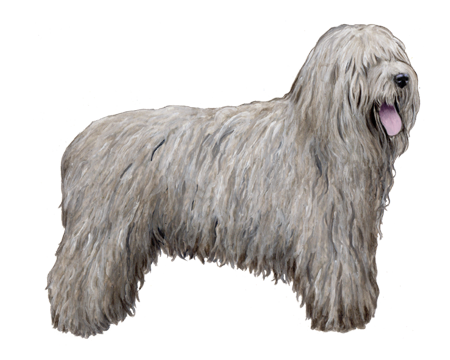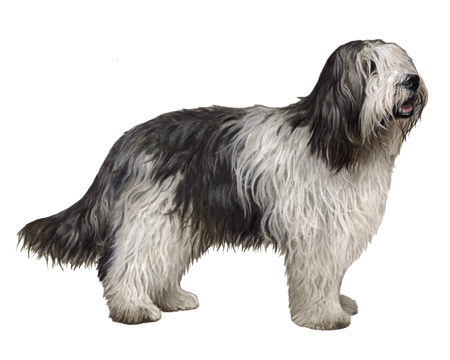
Briard
Briards are confident, faithful dogs that are ideal for families. The same protective instinct that allowed Briards to guard livestock for centuries extends to children, whom the dogs see as their flock.
Interested in discovering if your dog is a Briard?
Check out Wisdom Panel's DNA tests.
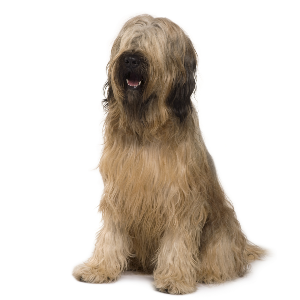
Briard Traits
General Appearance
The Briard is considered a “handsome” dog with strong bones and muscles and confident gaze.
The breed is powerful without being coarse and moves with a supple, light gait that gives it the appearance of gliding without touching the ground.
Coat and Colouring
Briards have double coats. Their undercoats are fine and tight across their bodies, and their outercoats are coarse and hard; the outer coat lies flat, falling naturally in long, slightly waving locks that can grow to more than six inches in length. Their heads are well covered with hair that lies down and has a natural part in the center, while their eyebrows arch up and out in a curve that creates a veil over their eyes.
The breed standard allows for Briards in all uniform coat colors except white. The most common colors include black, gray, and tawny. All shades are allowed but deeper shades of each color are preferred; combinations of two of these colors are also allowed.
Distinctive Physical Traits
Briards are strong in muscle and bone with broad, deep chests and powerful forequarters and hindquarters that move with flexible, tireless movements. These dogs have uncut, well-feathered tails that are carried low but do not deviate to the right or left; high-set ears that face forward when alert and are well open with long hair falling over the opening; and large, well-opened, and calm eyes.
Briard Temperament
Like other herding and guardian breeds, the Briard is fearless, never timid. These dogs excel in their work thanks to their high spirits, initiative, and stamina but also have the faithful, gentle, obedient natures that make them ideal as companions.
Briards are great with children, looking out for them like members of the flock, and shows great love and loyalty to their owners. These are active dogs and can easily overwhelm novice dog owners or those unprepared to meet their exercise needs.
The breed also retains its ancestral instinct to guard its home, including its owners. Socialization can help Briards feel more comfortable with strangers and ease their territorial natures.
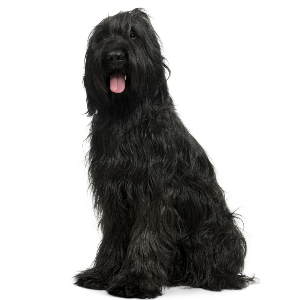
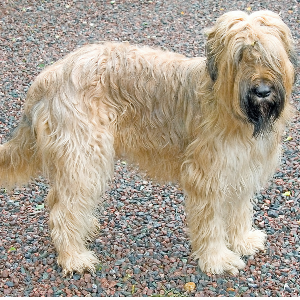
Briard History
Descendants of European guard dogs, Briards got their start in the Brie region of France. Known as Chien Berger de Brie in their homeland, these active, agile dogs were used to both herd sheep and guard the flocks. Their skill made the Briard so popular that it became somewhat of an institution in France.
The Briard was named the official war dog of the French army. During World War I, Briards served in the trenches, performing sentry duty, finding wounded soldiers, and pulling carts full of supplies.
Once a breed belonging to French farmers and peasants, the Briard got a boost from several high-profile owners. Napoleon owned a Briard and Thomas Jefferson purchased a pregnant Briard during his tenure as the ambassador to France. Upon his return to the United States, Jefferson put the dog to work at Monticello—but she was more than a working dog; she helped establish the breed outside of Europe.
Briard Care
Nutrition
Feed Briards a high-quality dog food that is appropriate for their life stage (puppy, adult, senior) and consider a diet formulated for active breeds. Like all dogs, Briards could become overweight if they are allowed to eat as much as they want. Portioning out their food with a measuring cup and limiting treats to no more than 10% of their daily calories can help keep these dogs fit and trim.
Grooming
Briards need to be brushed at least once per week to remove dead hair and prevent tangles. Their long double coats require daily brushing during spring and fall. An undercoat rake can help reduce shedding. Keep their ears clean and their nails trimmed.
Briards also benefit from a regular dental care routine that includes at-home teeth brushing and professional cleanings.
Exercise
Briards are working dogs that require lots of exercise. These dogs love brisk walks, hiking, and tagging along on bike rides. A large fenced area where Briards can play off leash will also help burn off some of their abundant energy. Briards also excel in dog sports such as competitive obedience, agility, tracking, flyball, rally, and herding.
Regular socialization, starting when Briards are puppies, will help them feel more comfortable with strangers.
Training
Briards were bred to work solo, making decisions without specific commands from their owners; it is a trait the breed has carried through history and can make them difficult to train. These dogs are smart and can learn new things easily but may choose to ignore commands.
Appeal to the Briard’s eager-to-please natures with positive reinforcement and rewards-based training. A training regimen that is consistent and fast-paced will appeal to the energetic working dogs and help channel their energy in positive directions.

Briard Genetic Health Conditions
-
Congenital Stationary Night Blindness (CSNB)
Congenital Stationary Night Blindness (CSNB) is an eye (retinal) disorder that causes non-progressive or very slowly progressing loss of night vision.
Knowing if your Briard is a carrier or at-risk for these conditions can help you and your veterinarian plan for your pup's lifelong care. With Wisdom Panel™ Premium, you can get results for over 200 genetic health tests.
Breed Group
Herding
The herding group is a diverse category. These highly intelligent breeds were developed to guard and control the movement of livestock.
Resources
https://www.akc.org/dog-breeds/briard/
http://images.akc.org/pdf/breeds/standards/Briard.pdf
Reviewed 26 July 2020 by Laura Inman, DVM











